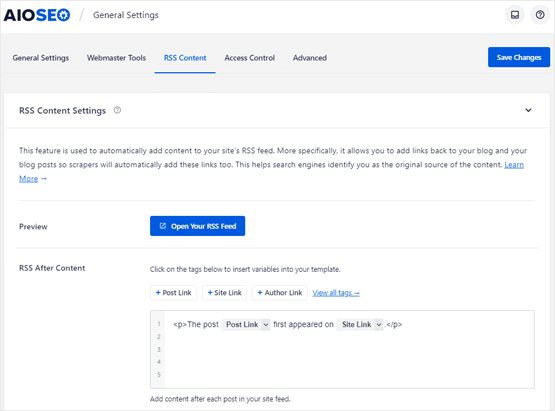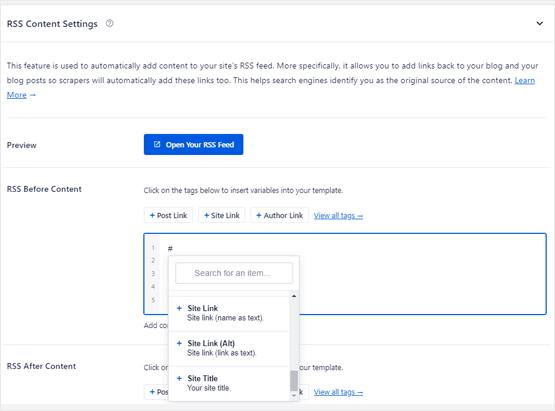RSS Footer Plugin for WordPress
Take control of your RSS feed to add credits, custom text and links, or even advertisements to help monetize your blog.

Protect your work from content scrapers.
When content scrapers republish posts from your blog’s RSS feed, it can damage your SEO rankings.
All in One SEO makes it easy to add automatic credits to the end of each post in your RSS feed, so you can make sure to get the proper credit from Google for your work.
Complete product page SEO tools
Unlock more potential from your RSS feeds.
- Monetize your feeds by adding Google AdSense, affiliate links, or banner ads
- Boost engagement by interlinking more content for your readers
- Increase conversions by linking to your highest converting pages

Explore All Our Powerful SEO Features
Here are all the features that make All in One SEO the best WordPress SEO plugin.
Improve your WordPress SEO Rankings with AIOSEO
Get the most powerful All in One WordPress SEO plugin and improve your website search rankings today.
(Instant Download)
Even more powerful SEO features
- Easily add title, meta description, keywords, and everything you need for on-page SEO optimization
- Complete support for Google Knowledge Graph and Schema rich snippets
- Easily connect with Google Search Console, Bing, Yandex, Baidu, and Pinterest webmaster tools
- Advanced eCommerce SEO support for WooCommerce, so you can optimize product pages, product categories, and more.
- Automatically notify search engines like Google and Bing about changes to your site.
RSS Footer Plugin for WordPress
Are you looking to customize your RSS feed footer in WordPress? Customizing your RSS feed footer was never this easy! With All in One SEO, you can add custom links and text at the end of your post in the RSS feed.
This article will show you how to add a footer to your RSS feed with WordPress plugin AIOSEO.
Let’s get started…
Why Do You Need to Add a Footer to Your RSS Feed?
RSS feeds are a default feature of WordPress out of the box. They provide a simple way to get updates whenever new content is published.
Despite its advantages, content scrapers can use RSS feeds to steal and copy your blog posts as soon as you publish them. What’s worse is that sometimes sites that stole your content might end up ranking higher than you!
Adding a custom text and link to your RSS feed footer can prevent this from happening, as you will still get the credit even if your blog is republished someplace else.
You can use this text to add backlinks and the link to the original post at the end of the blog post. This prevents content scrapers from ranking higher than your website.
You can also encourage readers to visit your blog from time to time by adding content to your RSS feed footer.
Let’s take a look at how to add content to RSS feed footer using AIOSEO.
How to Add Content to RSS Feed Footer
You can easily add content to the RSS feed footer using AIOSEO. You won’t have to mess around with a single line of code to get this done.
To get started, go to All in One SEO » General Settings in your WordPress dashboard and then click on RSS Content.

On the RSS Content page you will see three sections: Preview, RSS Before Content, and RSS After Content.
If you click on the Open Your RSS Feed button, you will be asked to download the RSS feed file, which you can view using any RSS reader.
In the next section, RSS Before Content, you can add the content at the start of your post. For example, you could add, “This post first appeared on [your domain].”
You can use tags from the View all tags dropdown.

Below that, you will see the RSS After Content section. This will allow you to add your content at the end of the blog post.
AIOSEO automatically adds custom text with a backlink to your website in the RSS feed footer. You can use the text as it is, or you can change it and add your own content.
Don’t forget to click on Save Changes once you are done.
You can now check to see if it worked. At the end of each article, you should see the text you added in the RSS feed.
To view your RSS feed, you can visit https://www.example.com/feeds. Just replace “example.com” with your site URL. This is the default RSS feed URL for all WordPress websites.
That’s it, you’re done!
We hoped this guide helped you understand the importance of adding an RSS feed footer to your WordPress website. Adding an RSS feed footer can be complicated if you’re doing it manually without a plugin, but with AIOSEO, it only takes a few minutes.
Frequently Asked Questions and Resources
Do you have a question about AIOSEO? See the list below for our most frequently asked questions. If your question is not listed here, then please contact us.
With All in One SEO, it’s easy to add content before or after your default RSS feed.
You can add plain text, links, and even dynamic tags to automatically add content to your feeds.
Our dynamic tags for RSS feeds include:
With All in One SEO, it’s easy to customize your RSS feed as needed.
- Post information: Your post title, link, publication date, and even the main category
- Site information: Your site title and main website link
- Author information: Display the author’s name and link to their archive page
With All in One SEO, it’s easy to customize your WordPress RSS feed the way you need it.
All in One SEO is perfect for business owners, bloggers, designers, developers, photographers, and basically everyone else. If you want to optimize your WordPress SEO, then you need to use All in One SEO Pack.
All in One SEO is a WordPress Plugin. In order to use All in One SEO pack, you must have a self-hosted WordPress site. That’s all.
Absolutely not. You can optimize your WordPress SEO without any coding knowledge. All in One SEO is one of the most beginner friendly WordPress SEO plugin.
Absolutely not. All in One SEO is carefully built with performance in mind. We have developed everything with best practices and modern standards to ensure things run smooth and fast.
Yes, All in One SEO has full translation and localization support. All in One SEO has been translated into 10 languages so far with many more on the way.
No. All in One SEO is a WordPress SEO plugin, so it will NOT work on sites that do not use WordPress. Additionally, All in One SEO is not compatible with the WordPress.com platform. You must be using a self-hosted version of WordPress to utilize All in One SEO.
Yes, you can use All in One SEO on client sites in two ways. Either you can purchase the Pro / Agency license OR purchase an appropriate license for each client sites. You can also refer your clients to purchase directly from our site using your affiliate link to earn a 20% commission.